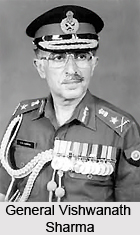 General Vishwanath Sharma came off a distinguished military family. His father was Major General Amarnath Sharma. He took retirement as the Deputy Director General of Medical Services. One of his two older brothers Major Somnath Sharma was posthumously awarded the Param Vir Chakra, the highest gallantry award of India for courageousness in the battle of Bagdam in Kashmir in October 1947.His another brother retired from the Army as Engineer-in-Chief (EMC). His younger sister, Kamla Tewary, is a doctor and served as Major General in the Indian Army.
General Vishwanath Sharma came off a distinguished military family. His father was Major General Amarnath Sharma. He took retirement as the Deputy Director General of Medical Services. One of his two older brothers Major Somnath Sharma was posthumously awarded the Param Vir Chakra, the highest gallantry award of India for courageousness in the battle of Bagdam in Kashmir in October 1947.His another brother retired from the Army as Engineer-in-Chief (EMC). His younger sister, Kamla Tewary, is a doctor and served as Major General in the Indian Army.
General Vishwanath Sharma received his education from Sherwood College, Nanital and later from the Prince of Wales` Royal Indian Military College at Dehradun.He also did courses from Indian Military Academy, Dehradun. During this time he got first the Rajputana Rifles Gold Medal for his skill and exceptional power of leadership. General Vishwanath Sharma was commissioned into the 16 Light Cavalry on 04 June 1950 and he served this Armored Regiment for next16 years. During long tenure General Vishwanath Sharma held many prestigious posts of commander, staff appointments and instructional assignments. He was posted in the Lahore sector as a young general during the war against Pakistan in 1965.After that he was promoted as Lieutenant Colonel. He commanded the 66 Armoured Regiment. General Vishwanath Sharma was given the post of instructor at the Defense Services Staff College, Wellington.
In the war against Pakistan General Vishwanath Sharma led an Armoured Division as the Colonel General Staff. After the war he rose to the rank of Brigadier and subsequently commanded a mountain brigade in an insurgency affected area. For outstanding performance General Vishwanath Sharma was decorated with Ati Vishisht Seva Medal. He was then appointed as Brigadier General Staff of a Strike Corps in the Western sector and led an armored Brigade in the desert of Rajasthan. On promotion to the Major General he successfully led a mountain division in the eastern sector in 1980. After that he was appointed as Deputy Director of the General Military Operations at the Army HQ in New Delhi. He was promoted to Lieutenant General and given the charge of a reserve Corps in the Western sector in 1984.For his distinguished service he was conferred with Param Vishisht Seva Medal (PVSM) in 1986.
General Vishwanath Sharma was the alumnus of the Defence Services Staff College, Wellington and the National Defence College, New Delhi. He was also the Commandant of the prestigious College of Combat at Mhow.On 30 April 1988; General Vishwanath Sharma assumed charge of the Indian Army, as the 15th Chief of Army Staff. He was an expert of mobile operations and mountain warfare. He had varied experiences in serving in the difficult most terrains and border regions. In 1987 General Vishwanath Sharma was served as the Honorary Army ADC to the President. General Vishwanath Sharma took retirement on 30 June 1990.






